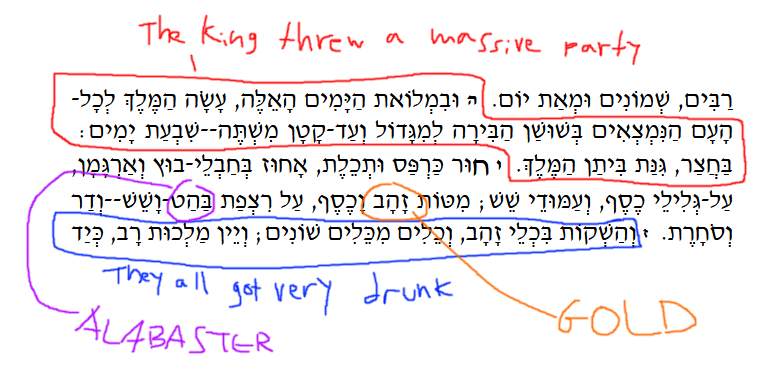A bit of geological/mineralogical/etymological fun.
Both #gold and #gypsum (as alabaster) appear in the Book of Esther. https://abs.twimg.com/emoji/v2/... draggable="false" alt="🪙" title="Coin" aria-label="Emoji: Coin">
https://abs.twimg.com/emoji/v2/... draggable="false" alt="🪙" title="Coin" aria-label="Emoji: Coin"> https://abs.twimg.com/emoji/v2/... draggable="false" alt="🍷" title="Weinglas" aria-label="Emoji: Weinglas">
https://abs.twimg.com/emoji/v2/... draggable="false" alt="🍷" title="Weinglas" aria-label="Emoji: Weinglas"> https://abs.twimg.com/emoji/v2/... draggable="false" alt="🍻" title="Anstoßende Bierkrüge" aria-label="Emoji: Anstoßende Bierkrüge">
https://abs.twimg.com/emoji/v2/... draggable="false" alt="🍻" title="Anstoßende Bierkrüge" aria-label="Emoji: Anstoßende Bierkrüge"> https://abs.twimg.com/emoji/v2/... draggable="false" alt="🥂" title="Anstoßende Gläser" aria-label="Emoji: Anstoßende Gläser">
https://abs.twimg.com/emoji/v2/... draggable="false" alt="🥂" title="Anstoßende Gläser" aria-label="Emoji: Anstoßende Gläser"> https://abs.twimg.com/emoji/v2/... draggable="false" alt="👑" title="Krone" aria-label="Emoji: Krone">
https://abs.twimg.com/emoji/v2/... draggable="false" alt="👑" title="Krone" aria-label="Emoji: Krone"> https://abs.twimg.com/emoji/v2/... draggable="false" alt="🏰" title="Europäisches Schloss" aria-label="Emoji: Europäisches Schloss">
https://abs.twimg.com/emoji/v2/... draggable="false" alt="🏰" title="Europäisches Schloss" aria-label="Emoji: Europäisches Schloss">
Both #gold and #gypsum (as alabaster) appear in the Book of Esther.
That part in the middle with gold and alabaster:
חוּר כַּרְפַּס וּתְכֵלֶת אָחוּז בְּחַבְלֵי בוּץ וְאַרְגָּמָן עַל גְּלִילֵי כֶסֶף וְעַמּוּדֵי שֵׁשׁ מִטּוֹת זָהָב וָכֶסֶף עַל רִצְפַת בַּהַט וָשֵׁשׁ וְדַר וְסֹחָרֶת.
This is a description of the palace.
חוּר כַּרְפַּס וּתְכֵלֶת אָחוּז בְּחַבְלֵי בוּץ וְאַרְגָּמָן עַל גְּלִילֵי כֶסֶף וְעַמּוּדֵי שֵׁשׁ מִטּוֹת זָהָב וָכֶסֶף עַל רִצְפַת בַּהַט וָשֵׁשׁ וְדַר וְסֹחָרֶת.
This is a description of the palace.
The second part of this describes some stones used to build the castle.
First, we have "רִצְפַת בַּהַט" - "ritzpat bahat". Bahat is the word used in Modern Hebrew to describe alabaster. Where this is what it meant back then, is a mystery. Gypsum isn& #39;t an ideal flooring material…
First, we have "רִצְפַת בַּהַט" - "ritzpat bahat". Bahat is the word used in Modern Hebrew to describe alabaster. Where this is what it meant back then, is a mystery. Gypsum isn& #39;t an ideal flooring material…
The second is "שֵׁשׁ", ("shesh"), which probably means שיש, the modern word for marble.
The third: "דַר" is probably mother-of-pearl. There is "door" (دُرّ) in Arabic with the same meaning.
The third: "דַר" is probably mother-of-pearl. There is "door" (دُرّ) in Arabic with the same meaning.
The last word "סֹחָרֶת" has no modern equivalent and no one knows what it is.
Other than the second word (שש - marble), all other words only appear once in the bible. This makes is challenging translate them to other languages.
Let& #39;s look at some:
Other than the second word (שש - marble), all other words only appear once in the bible. This makes is challenging translate them to other languages.
Let& #39;s look at some:
NIV: "mosaic pavement of porphyry, marble, mother-of-pearl and other costly stones"
NKJV: "mosaic pavement of alabaster, turquoise, and white and black marble"
KJB: "upon a pavement of red, and blue, and white, and black, marble" ( https://abs.twimg.com/emoji/v2/... draggable="false" alt="🤔" title="Denkendes Gesicht" aria-label="Emoji: Denkendes Gesicht">)
https://abs.twimg.com/emoji/v2/... draggable="false" alt="🤔" title="Denkendes Gesicht" aria-label="Emoji: Denkendes Gesicht">)
NKJV: "mosaic pavement of alabaster, turquoise, and white and black marble"
KJB: "upon a pavement of red, and blue, and white, and black, marble" (
CSB: "mosaic pavement of red feldspar, marble, mother-of-pearl, and precious stones"
CEV: "pavement that had all kinds of designs made from costly bright-colored stones and marble and mother-of-pearl"
CEV: "pavement that had all kinds of designs made from costly bright-colored stones and marble and mother-of-pearl"
NET: " floor made of valuable stones of alabaster, mother-of-pearl, and mineral stone"
GWT: "mosaic pavement of purple rock, white marble, pearl-like stone, and black marble"
JPS: "pavement of green, and white, and shell, and onyx marble."
GWT: "mosaic pavement of purple rock, white marble, pearl-like stone, and black marble"
JPS: "pavement of green, and white, and shell, and onyx marble."
So it appears that in each translation, they just made up some rocks of whatever colour they can think of, and used that.
@MineralCup
@MineralCup

 Read on Twitter
Read on Twitter https://abs.twimg.com/emoji/v2/... draggable="false" alt="🍷" title="Weinglas" aria-label="Emoji: Weinglas">https://abs.twimg.com/emoji/v2/... draggable="false" alt="🍻" title="Anstoßende Bierkrüge" aria-label="Emoji: Anstoßende Bierkrüge">https://abs.twimg.com/emoji/v2/... draggable="false" alt="🥂" title="Anstoßende Gläser" aria-label="Emoji: Anstoßende Gläser">https://abs.twimg.com/emoji/v2/... draggable="false" alt="👑" title="Krone" aria-label="Emoji: Krone">https://abs.twimg.com/emoji/v2/... draggable="false" alt="🏰" title="Europäisches Schloss" aria-label="Emoji: Europäisches Schloss">" title="A bit of geological/mineralogical/etymological fun.Both #gold and #gypsum (as alabaster) appear in the Book of Esther.https://abs.twimg.com/emoji/v2/... draggable="false" alt="🪙" title="Coin" aria-label="Emoji: Coin">https://abs.twimg.com/emoji/v2/... draggable="false" alt="🍷" title="Weinglas" aria-label="Emoji: Weinglas">https://abs.twimg.com/emoji/v2/... draggable="false" alt="🍻" title="Anstoßende Bierkrüge" aria-label="Emoji: Anstoßende Bierkrüge">https://abs.twimg.com/emoji/v2/... draggable="false" alt="🥂" title="Anstoßende Gläser" aria-label="Emoji: Anstoßende Gläser">https://abs.twimg.com/emoji/v2/... draggable="false" alt="👑" title="Krone" aria-label="Emoji: Krone">https://abs.twimg.com/emoji/v2/... draggable="false" alt="🏰" title="Europäisches Schloss" aria-label="Emoji: Europäisches Schloss">" class="img-responsive" style="max-width:100%;"/>
https://abs.twimg.com/emoji/v2/... draggable="false" alt="🍷" title="Weinglas" aria-label="Emoji: Weinglas">https://abs.twimg.com/emoji/v2/... draggable="false" alt="🍻" title="Anstoßende Bierkrüge" aria-label="Emoji: Anstoßende Bierkrüge">https://abs.twimg.com/emoji/v2/... draggable="false" alt="🥂" title="Anstoßende Gläser" aria-label="Emoji: Anstoßende Gläser">https://abs.twimg.com/emoji/v2/... draggable="false" alt="👑" title="Krone" aria-label="Emoji: Krone">https://abs.twimg.com/emoji/v2/... draggable="false" alt="🏰" title="Europäisches Schloss" aria-label="Emoji: Europäisches Schloss">" title="A bit of geological/mineralogical/etymological fun.Both #gold and #gypsum (as alabaster) appear in the Book of Esther.https://abs.twimg.com/emoji/v2/... draggable="false" alt="🪙" title="Coin" aria-label="Emoji: Coin">https://abs.twimg.com/emoji/v2/... draggable="false" alt="🍷" title="Weinglas" aria-label="Emoji: Weinglas">https://abs.twimg.com/emoji/v2/... draggable="false" alt="🍻" title="Anstoßende Bierkrüge" aria-label="Emoji: Anstoßende Bierkrüge">https://abs.twimg.com/emoji/v2/... draggable="false" alt="🥂" title="Anstoßende Gläser" aria-label="Emoji: Anstoßende Gläser">https://abs.twimg.com/emoji/v2/... draggable="false" alt="👑" title="Krone" aria-label="Emoji: Krone">https://abs.twimg.com/emoji/v2/... draggable="false" alt="🏰" title="Europäisches Schloss" aria-label="Emoji: Europäisches Schloss">" class="img-responsive" style="max-width:100%;"/>


